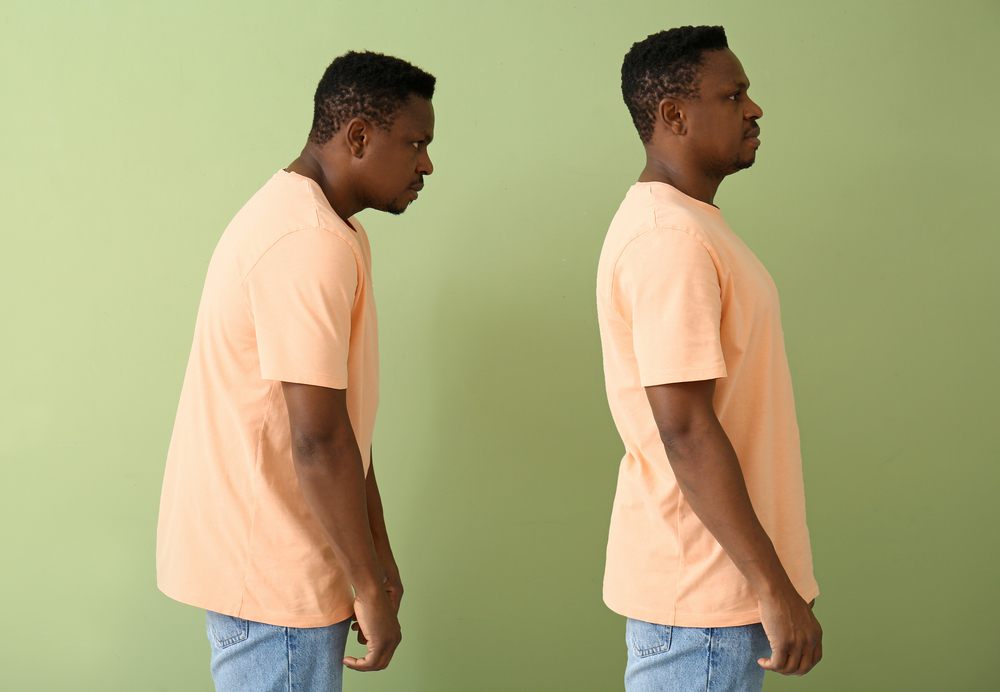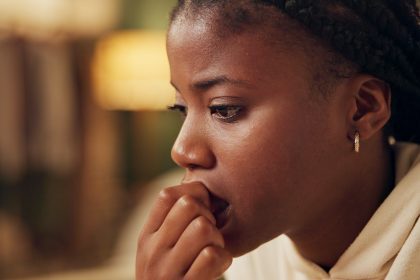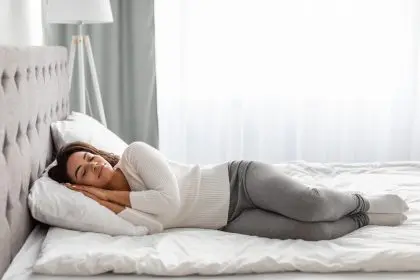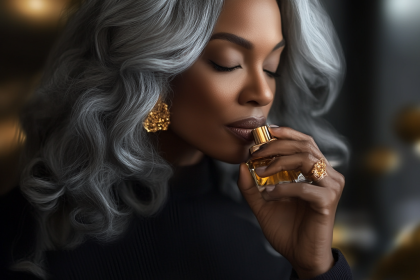You might choose your words carefully, but your body is having an entirely different conversation. That slight slouch, the tilt of your head, the way you cross your arms—these subtle physical signals broadcast your mental state to everyone around you, often without your awareness. Your posture isn’t just about how you hold yourself, it’s a window into what’s happening inside your mind.
The confidence code
When someone walks into a room with shoulders back, head held high, and a straight spine, you immediately sense their confidence. This isn’t just social perception, it’s rooted in a genuine mind-body connection. The expanded posture that comes with confidence literally changes your brain chemistry, boosting testosterone and lowering cortisol levels.
This postural signature of confidence involves taking up space unapologetically. The arms stay away from the body rather than tucked protectively against it. The chest opens rather than collapsing inward. Weight distributes evenly between both feet in a stable, grounded stance that communicates security in one’s position—both physically and metaphorically.
What makes this particularly fascinating is how the relationship works both ways. Not only does confidence create this expanded posture, but deliberately adopting these physical positions can actually generate feelings of confidence when they’re lacking. Your body posture doesn’t just express your mental state, it helps create it.
The anxiety architecture
Anxiety sculpts the body in remarkably consistent ways. The shoulders hunch forward as if bracing for impact. The chest caves inward, protecting vital organs. The head juts forward, narrowing the back of the neck. Arms cross or hands fidget, creating physical barriers between the person and their environment.
This protective posture makes perfect evolutionary sense. When our ancestors faced physical threats, this contracted position shielded vulnerable body parts. Today, our threats are more often psychological, but our bodies respond with the same ancient programming.
The postural signature of anxiety also includes microexpressions that happen below conscious awareness—slightly widened eyes that scan the environment for threats, shallow breathing confined to the upper chest, and muscle tension that keeps the body perpetually ready for flight or fight.
The depression descent
Depression literally weighs on the body. The posture associated with low mood appears as if gravity has become stronger, pulling everything downward. The shoulders round and slump. The head hangs with the gaze directed toward the ground. Even the facial muscles seem to drop, with the corners of the mouth turning slightly downward in their resting position.
This collapsed posture reflects both the emotional and energetic aspects of depression. Emotionally, the inward-turning, diminished posture mirrors the psychological withdrawal that often accompanies depression. Energetically, it reflects the profound fatigue and effort that simple tasks require when battling this condition.
The walking pattern also changes, becoming slower with shorter steps and reduced arm swing. This isn’t just a reflection of sadness—it’s the physical manifestation of how depression affects the motivation centers in the brain, literally reducing the drive that propels the body forward through space.
The power position
Some postures don’t just reflect power—they create it. The expansive postures associated with authority and dominance actually trigger hormonal changes that make you feel more powerful. Standing with feet shoulder-width apart, hands on hips, chin slightly elevated—this “superhero stance” increases testosterone and decreases stress hormones within minutes.
In contrast, positions of powerlessness manifest as making yourself physically smaller. The shoulders curve inward, arms cross over the abdomen, the body takes up minimal space. This contracted posture signals submission and triggers corresponding hormonal shifts that reinforce feelings of powerlessness.
What’s remarkable is how quickly these postural effects occur. Just two minutes in either a high-power or low-power pose creates measurable hormonal changes that affect how you think, feel, and behave in subsequent interactions. Your physical position literally reshapes your brain’s approach to challenges and opportunities.
The defensive displays
When feeling threatened, criticized, or insecure, the body creates barriers between itself and perceived threats. Arms cross tightly over the chest. Legs cross and twist around each other. The head tilts down while the eyes look up—a position that combines protection with vigilance.
These defensive postures happen automatically when we feel psychologically unsafe, creating physical barriers where emotional ones exist. Even in professional settings, you can often identify who feels attacked in a meeting by watching for these subtle protective adjustments in posture.
Interestingly, these same positions sometimes appear when someone is internally conflicted or being dishonest. The body attempts to protect itself from uncomfortable internal states just as it does from external threats. This explains why body language experts watch for these defensive postures during high-stakes interviews or negotiations.
The authentic alignment
When someone’s words and posture tell the same story, we perceive authenticity. But when they clash, we instinctively trust the body over the words. This is why someone can say they’re fine while their collapsed posture tells us they’re anything but okay.
Authentic posture has a quality of integration—the whole body tells a cohesive story rather than showing contradictory signals. When truly comfortable and congruent, the body displays open, relaxed alignment without excessive tension or protective positioning, regardless of whether the emotional state is positive or negative.
This alignment between internal state and external expression requires self-awareness. Many people maintain habitual postures that contradict their actual feelings, creating a chronic disconnect between their inner experience and outer expression that registers as inauthentic to others.
The stress signature
Stress creates perhaps the most recognizable postural pattern—shoulders rising toward the ears, jaw clenching, forehead tightening, and breathing becoming shallow and confined to the upper chest. This tension constellation emerges so consistently that massage therapists can often accurately guess their clients’ stress levels before they say a word.
Beyond these obvious signs, chronic stress creates more subtle postural changes. The body develops protective patterns around vulnerable areas, particularly the heart and abdomen. The chest collapses slightly inward, creating a protective cave around the heart. The abdominal muscles remain partially contracted even when supposedly at rest.
These stress-induced patterns don’t fully release even during sleep, leading to the characteristic stiffness many people feel upon waking. The body essentially gets locked into stress postures that persist beyond the stressful events themselves, creating a feedback loop where posture continues generating stress hormones even when external stressors are absent.
The attention indicators
How we position our bodies reveals what we’re paying attention to—both externally and internally. When genuinely engaged with another person, the feet, torso, and face all align toward them. Even when the head turns away momentarily, the feet often remain pointed toward the person who truly holds our attention.
Conversely, when mentally preoccupied, the body reveals divided attention. The feet may point toward the exit while the torso twists to face the conversation partner. The head nods while the fingers fidget with a phone. These misalignments between body parts communicate that while part of you is present, another part is already moving on.
This principle extends to internal attention as well. Someone lost in thought often displays a slightly unfocused gaze, reduced blinking, and diminished awareness of their physical positioning. The body becomes still in a way that signals attention has turned inward rather than outward.
The emotional echoes
Each emotion creates its own postural echo in the body. Beyond the obvious examples of depression and anxiety, emotions like shame, pride, disgust, and contentment each shape the body in distinctive ways.
Shame collapses the chest and rounds the shoulders while the chin tucks, making the person physically smaller. Pride does the opposite, expanding the chest while drawing the shoulders back and lifting the chin. Disgust creates a recoiling motion, with the torso pulling back while the chin juts forward. Contentment allows the body to settle, releasing tension while maintaining aligned support.
These physical patterns are so consistent across cultures that people can often identify emotions from posture alone, even without seeing facial expressions. Our bodies speak an emotional language that transcends cultural and linguistic boundaries.
The practical application
Understanding these connections between posture and mental state offers practical applications beyond just reading others. By consciously adjusting your posture, you can influence your own emotional state and how others perceive you.
Before important interactions, taking a moment to adjust your posture can shift both your hormonal balance and subjective experience. Straightening the spine, relaxing the shoulders down away from the ears, and lifting the chest slightly can create physiological changes that increase confidence and reduce anxiety.
Similarly, noticing when your posture has collapsed into patterns associated with negative emotional states gives you valuable information about your mental condition, sometimes before you’ve consciously registered the emotion itself. This awareness creates an opportunity to address the underlying feelings or deliberately shift your physical position to influence your psychological state.
The habitual patterns
Perhaps most revealing are the postural habits that become our default ways of moving through the world. These aren’t momentary responses to specific situations but rather physical manifestations of our chronic mental patterns.
Someone who has experienced long-term criticism might develop a permanently protective posture, with shoulders rounded and head slightly tucked even in non-threatening situations. A person with persistent anxiety might maintain chronically elevated shoulders and restricted breathing patterns even during supposedly relaxed activities.
These habitual patterns become so ingrained that changing them requires both physical and psychological work. Simply telling someone to “stand up straight” rarely creates lasting change because these postures aren’t just physical habits—they’re embodied aspects of identity and emotional history.
The most effective approaches address both the physical patterns through movement education and the psychological patterns through awareness practices. As mental patterns shift, posture naturally follows, and as posture changes, mental patterns begin to transform in a virtuous cycle of mind-body integration.












